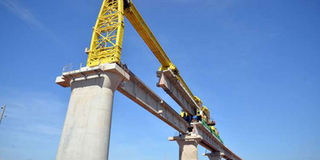Mega Sh217bn railway cities a step closer to reality

Ongoing construction works of the Standard Gauge Railway at Voi Taita Taveta County on March 15, 2016. PHOTO | SALATON NJAU | NATION MEDIA GROUP
What you need to know:
- At Sh217 billion, the railway cities are on course to becoming the second-largest single project in Kenya’s history, after the Sh327 billion standard gauge railway planned for completion mid-next year.
Kenya is getting closer to constructing commercial hubs around railway stations in Nairobi, Mombasa and Kisumu at an estimated cost of Sh217 billion.
The government had commissioned studies to determine the most effective investment option for the mega projects that will involve office complexes, hotels, shopping malls, industrial parks and arcades on land surrounding railway stations.
Construction will be done through a mix of joint ventures, franchises and build operate transfer (BOT), according to an inter-governmental team comprising ministries of Transport alongside Land and Housing.
The BOT arrangement is where companies invest cash in a project, operate for some time to recoup expenditure and make a profit, before handing it over to the government.
At Sh217 billion, the railway cities are on course to becoming the second-largest single project in Kenya’s history, after the Sh327 billion standard gauge railway planned for completion mid-next year.
“The project will be developed through build operate transfer, franchises and joint ventures under land lease,” says the intergovernmental team.
“The estimated cost of the project is $2.15 billion (Sh217 billion).”
The government expects to earn about Sh1 billion in annual land lease fees.
The project will involve railway stations upgrade and construction of direct rail links with major airports in the three local cities. It will sit on about 400 acres of land in the three cities, including Voi town.
The plan is to link the railway cities from the Coast to the capital city and to the lakeside region, is crucial in seamless movement of goods and people.
According to earlier designs by Kenya Railways — in charge of project implementation — Nairobi’s railway station in the city centre will host a shopping mall, restaurants, a manufacturing park and two hotels with a capacity of 3,000 people.
Officials seek to fashion Kenya’s capital as the regional hub for commuter and intercity transport and will be connected to Jomo Kenyatta International Airport (JKIA) by a direct railroad.
The connection with the JKIA is particularly crucial in curbing congestion on roads connecting to the main airport.
The airport is also expected to host its first industrial park for light industries producing beauty and healthcare products, electrical and electronics, pharmaceuticals.
According to designs, the coastal city of Mombasa will host an international trade centre, office blocks, a shopping mall and two hotels.




